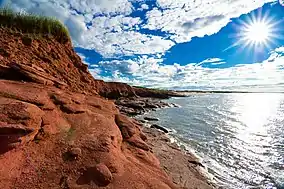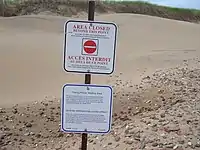| Prince Edward Island National Park | |
|---|---|
 | |
 Location in Canada  Location of in Prince Edward Island | |
| Location | Prince Edward Island, Canada |
| Nearest city | Charlottetown |
| Coordinates | 46°25′00″N 63°04′30″W / 46.41667°N 63.07500°W |
| Area | 27 km2 (10 sq mi) |
| Established | 1937 |
| Governing body | Parks Canada |
Prince Edward Island National Park (French: Parc national de l'Île-du-Prince-Édouard) is a National Park of Canada located in the province of Prince Edward Island. Situated along the island's north shore, fronting the Gulf of St. Lawrence, the park measures approximately 60 km (37 mi) in length and ranges from several hundred metres to several kilometres in width. Established in 1937, the park's mandate includes the protection of many broad sand beaches, sand dunes and both freshwater wetlands and saltmarshes. The park's protected beaches provide nesting habitat for the endangered piping plover;[1] the park has been designated a Canadian Important Bird Area.
An extension was added to the park in 1998 when an extensive sand dune system in Greenwich was transferred from the provincial government to Parks Canada.[1] The Prince Edward Island National Park also includes Green Gables, which was the childhood inspiration for the Anne of Green Gables novels by author Lucy Maud Montgomery, as well as Dalvay-by-the-Sea, a Victorian era mansion currently operated as an inn.
In 1999, the Canadian Nature Federation identified Prince Edward Island National Park as being the most endangered in the national park system, based on human impact.[2] The park also experiences severe coastal erosion as a result of winter storms and its vulnerable shoreline.
The park was the subject of a short film in 2011's National Parks Project, directed by John Walker and scored by Chad Ross, Sophie Trudeau and Dale Morningstar. Part of the Jezero crater on Mars was informally named after the park.[3][4]
Wildlife
Animals that inhabit this national park are coyotes, red foxes, raccoons, beavers, minks, and weasels.[1] Numerous birds roam in this park including species of various herons, ducks, owls, cranes, plovers, grouses, jays, falcons, geese, hawks, sandpipers and eagles.[1]
Gallery
 Red sand beach in PEI National Park
Red sand beach in PEI National Park.jpg.webp) Lake of Shining Waters
Lake of Shining Waters Coast of Prince Edward Island
Coast of Prince Edward Island Restricted area for nesting piping plover
Restricted area for nesting piping plover Prince Edward Island National Park on Cavendish Beach
Prince Edward Island National Park on Cavendish Beach Pedestrian walk
Pedestrian walk Grassland
Grassland Prince Edward Island National Park's coast
Prince Edward Island National Park's coast Orientation table
Orientation table Dunes at Cavendish Beach
Dunes at Cavendish Beach
See also
References
- 1 2 3 4 National Geographic Guide to the National Parks of Canada, 2nd Edition. National Geographic Society. 2016. pp. 62–69. ISBN 978-1-4262-1756-2.
- ↑ "P.E.I. national park in peril". CBC News. December 13, 1999. Retrieved April 3, 2019.
- ↑ "Island-born scientist names section of Mars crater after P.E.I. National Park". CBC News. 29 July 2020. Retrieved 31 May 2021.
- ↑ "Perseverance Rover's Landing Site: Jezero Crater". Mars 2020. NASA. Retrieved 31 May 2021.